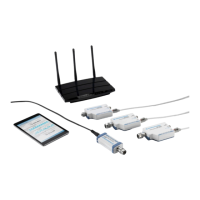Preparing for use
R&S
®
NRP Series
17Getting Started 1419.0170.02 ─ 16
Setup
NRP
3-Path Diode Power Sensor
MHz to GHz, 100 pW to 200 mW (−70 dBm to +23 dBm)
SMART SENSOR TECHNOLOGY
1
2
3
4
5
6
Figure 3-1: Setup with an R&S
NRP
‑
ZKU cable
1 = Signal source
2 = R&S NRP power sensor
3 = Host interface connector
4 = R&S NRP‑ZKU cable
5 = USB connector
6 = Computer with installed VISA driver or R&S NRP Toolkit
Set up as shown in Figure 3-1.
1. Connect the R&S NRP‑ZKU cable to the power sensor. See "To connect a
cable to the host interface of the power sensor" on page 15.
2. Connect the R&S NRP‑ZKU cable to the computer.
3. NOTICE! Incorrectly connecting or disconnecting the power sensor can dam-
age the power sensor or lead to erroneous results. Ensure that you connect or
disconnect the power sensor as described in Chapter 3.4, "Connecting to a
DUT", on page 13.
Connect the power sensor to the signal source.
4. On the computer, start a software application to view the measurement
results. See Chapter 5, "Operating concepts", on page 32.
3.7.1.2 R&S NRP‑Z5 sensor hub setup
The R&S NRP‑Z5 sensor hub (high-speed USB 2.0) can host up to four R&S
NRP power sensors and provides simultaneous external triggering to all connec-
ted sensors.
Required equipment
●
1 to 4 R&S NRP power sensors
Connecting to a controlling host

